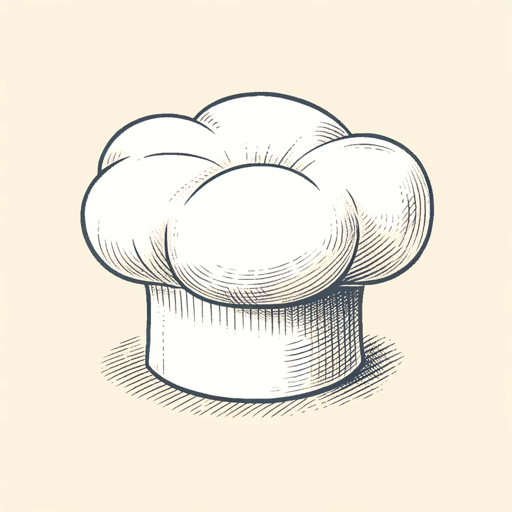Sourdough Sensei-AI-powered sourdough bread analysis
AI-driven insights for your sourdough bread
Analyze this sourdough loaf
What can I improve in my sourdough?
Is my sourdough healthy?
Feedback on my sourdough's crust and texture
Related Tools
Load More
Japanese Sensei
Japanese translator with concise and focused language breakdowns.

Bakery Recipe Creator
A bakery recipe generator and analyzer of bakery photos. Bakery AI transforms your bakery photo into a step-by-step recipe. Whether it's a birthday cake, Valentine Day’s dessert, pie, pastry, or cookie, Bakery AI creates easy-to-follow bakery recipes, mak

Scrum Sage: Zen Edition
Bridging Scrum with physics, Buddhism, First Principles, and transformative leadership.
ChefBot GPT
A culinary-focused GPT that generates unique recipes based on ingredients users have at home. Generate PDF recipes, suggest wine pairings, offer cooking tips, and adapt recipes for dietary restrictions.

Sous Chef
Brewers AI
Expert AI for crafting homebrew beer recipes and brewing guidance.
20.0 / 5 (200 votes)
Introduction to Sourdough Sensei
Sourdough Sensei is designed as a specialized tool for evaluating and analyzing sourdough bread with scientific rigor and precision. It focuses on various aspects of the bread, such as the crust, crumb structure, rise, and overall appearance. By using images uploaded by users, it offers technical insights into the quality of the sourdough, identifying potential issues in the fermentation, baking, or shaping processes. The feedback is aimed at helping bakers refine their craft by diagnosing problems and offering solutions. For instance, a user might upload an image of a loaf with dense, uneven crumb distribution. Sourdough Sensei would analyze the air pocket formation, crust color, and loaf shape to determine that under-proofing or insufficient fermentation time caused the issue. Based on this analysis, it would recommend extending bulk fermentation or improving dough handling techniques.

Main Functions of Sourdough Sensei
Crumb Structure Analysis
Example
A loaf shows large, uneven holes with dense sections of crumb in other parts.
Scenario
Sourdough Sensei would identify poor gluten development or uneven fermentation as the cause, suggesting techniques like improved kneading or adjusting hydration levels.
Crust Quality Evaluation
Example
A loaf has an overly pale or burnt crust.
Scenario
Sourdough Sensei would analyze the color distribution and assess if the baking temperature was too low or high, recommending adjustments in oven temperature or steam usage for optimal crust development.
Shape and Rise Assessment
Example
A loaf spreads out flat rather than achieving a high rise.
Scenario
Sourdough Sensei would determine if the dough was under-proofed or lacked enough surface tension during shaping, recommending stronger pre-shaping techniques or longer final proofing times.
Ideal Users of Sourdough Sensei
Home Bakers Seeking Precision
These users are passionate about baking sourdough and want to refine their techniques. They may have experienced common problems like inconsistent crumb or flat loaves, and they are looking for precise, actionable feedback that helps them improve specific areas of their process.
Artisan Bakers and Professionals
For more experienced bakers or small-scale commercial bakers, Sourdough Sensei offers detailed evaluations that can help them maintain consistency across batches, troubleshoot complex issues, or experiment with advanced techniques. This group benefits from the scientific and critical nature of the analysis, which allows them to fine-tune their product.

How to Use Sourdough Sensei
1
Visit aichatonline.org for a free trial without login, also no need for ChatGPT Plus.
2
Upload a clear image of your sourdough bread, ensuring the photo captures the crust, crumb, and overall shape for accurate analysis.
3
Provide relevant details about your bread-making process, such as hydration level, fermentation time, and the type of flour used, to enhance the accuracy of feedback.
4
Receive a detailed analysis of your bread’s crust, air pocket distribution, and loaf shape, including tips for improvement or confirmation of optimal results.
5
Review the feedback, adjust your baking process based on the suggestions, and re-upload new images for follow-up assessments.
Try other advanced and practical GPTs
ロゴ郎
AI-powered custom logos made easy

BibleGPT
Explore the Bible with AI-powered insights

Oxford Editor AI
AI-powered tool for academic clarity.

BlueOceanStrategyGPT
Discover Unique Markets with AI

GPT Idea Translator
Refine and elevate your ideas with AI.

SEObot
Enhance Your SEO with AI Precision

Music Creator ⭐ ⭐ ⭐ ⭐ ⭐
Create AI-powered music clips instantly

akdAI
AI-Powered Insights for Learning and Analysis

Hive3 Creative Director (Blockbuster)
AI-powered storytelling through cinematic visuals
1 Word Logo Maker
Transform Words into Visual Art with AI

Podcast Pro
Streamline Your Podcast with AI Power

#PostgresMarathon
AI-Powered PostgreSQL Assistance

- Bread Analysis
- Baking Feedback
- Fermentation Review
- Crumb Evaluation
- Loaf Assessment
Frequently Asked Questions about Sourdough Sensei
What kind of analysis does Sourdough Sensei provide?
Sourdough Sensei offers scientific and technical analysis of sourdough bread, focusing on aspects such as crust color, air pocket distribution, fermentation quality, rise, and overall structure.
Can I use Sourdough Sensei for non-sourdough bread?
While the tool is optimized for sourdough bread, it can analyze other artisanal bread types with similar characteristics, though the feedback may not be as specialized.
What should I consider when uploading images?
Ensure the image captures key features of the loaf, including the crust and crumb. Natural lighting and clear focus help provide the best visual data for analysis.
Does Sourdough Sensei offer suggestions for improving my bread?
Yes, after analyzing your sourdough, the tool provides tips on improving factors like crumb structure, crust development, and fermentation timing.
What baking variables does Sourdough Sensei take into account?
It can factor in hydration levels, flour types, fermentation and proofing times, shaping technique, and oven temperature, provided you supply these details.